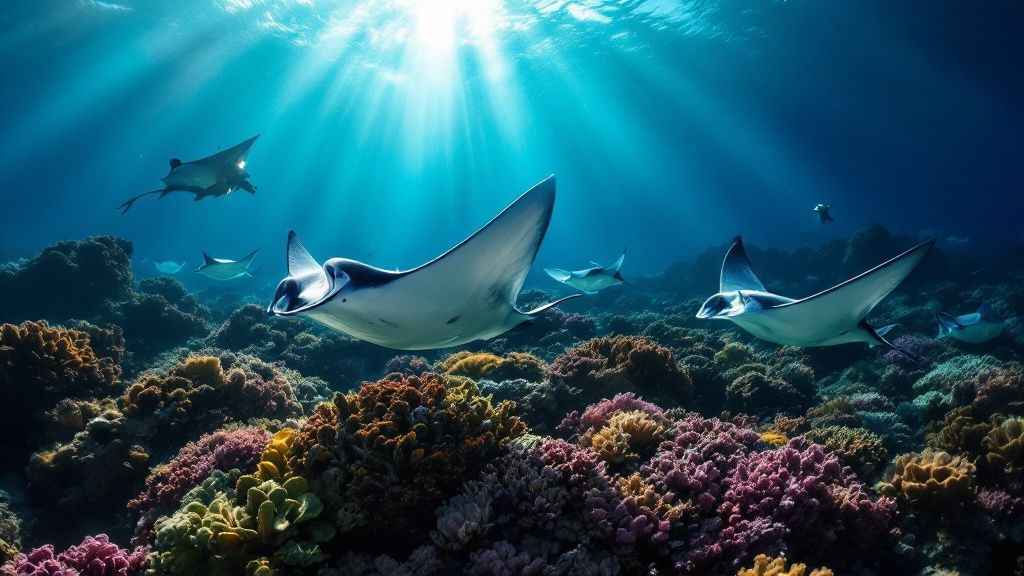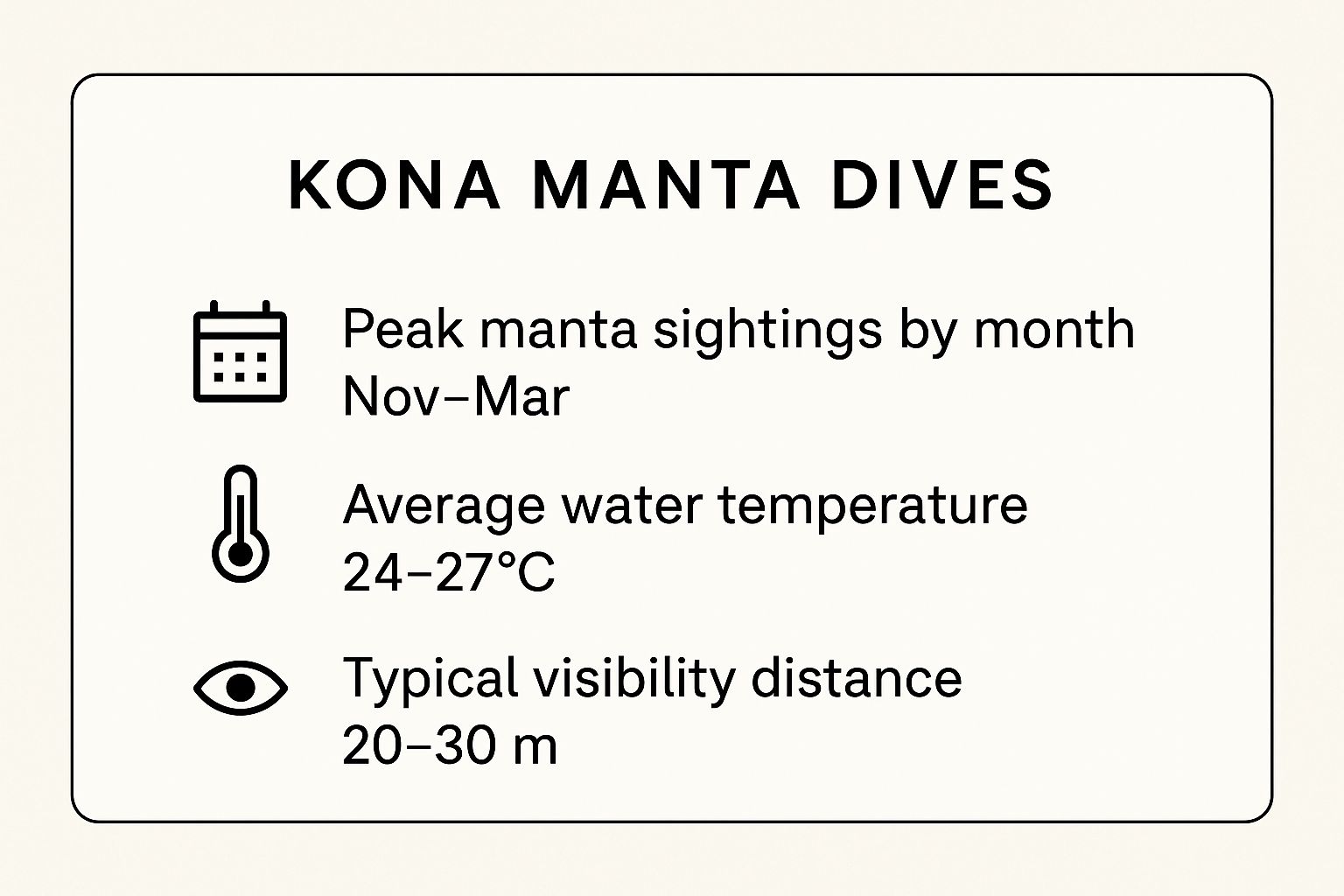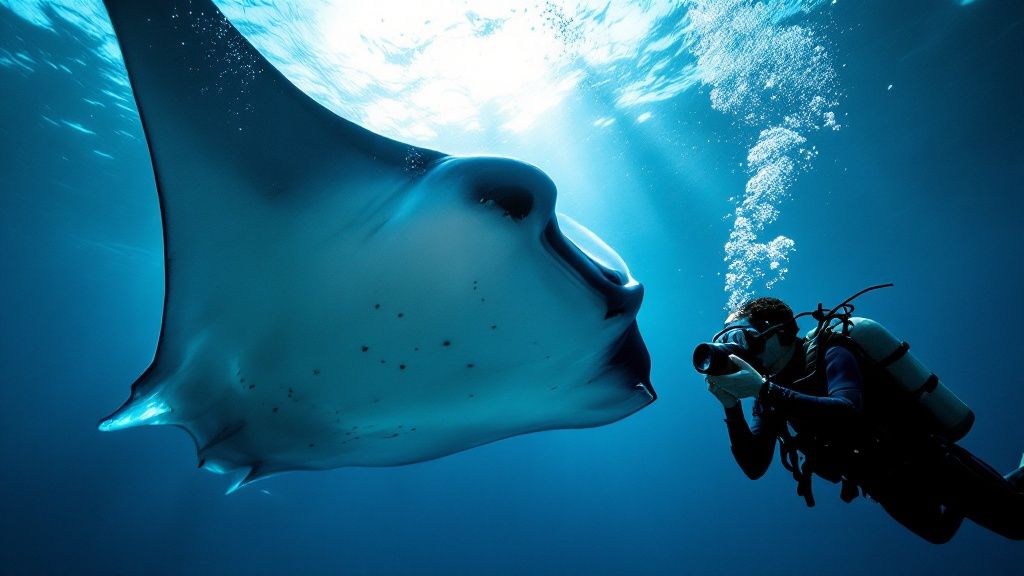Why Kona Reigns as the Manta Ray Capital of the World
Kona, Hawaii, isn't just a beautiful island destination; it's the place to be if you want to encounter manta rays. But what makes this location so special for these gentle giants? It all comes down to the perfect mix of environmental factors that create an unparalleled feeding ground, turning Kona into a true manta ray paradise.
One key ingredient is Kona's unique underwater topography. Volcanic slopes create deep, nutrient-rich waters surprisingly close to shore. This means plankton, the main food source for manta rays, thrives in abundance just off the coast. These nutrient-rich currents rise to the surface, providing a constant food supply that draws mantas in night after night. This reliability has made Kona a go-to spot for manta ray dive adventures.
Kona also boasts several protected bays, like Keauhou Bay (home to Manta Village) and Garden Eel Cove (affectionately known as Manta Heaven). These bays offer calm, shallow waters, ideal for both the manta rays and the people who come to see them. The shallow depths also enhance the "campfire effect" created by dive lights, attracting even more plankton and, as a result, more mantas. This creates a truly amazing opportunity for divers and snorkelers to witness these magnificent creatures up close. The Kona Coast is famous for consistent manta ray sightings, especially in these locations. Jack's Diving Locker reports seeing mantas 85-90% of the time, which speaks volumes about the consistency of these encounters. Find more detailed statistics here.
The Cultural Significance of Mantas in Kona
Beyond the biology, mantas hold deep cultural significance in Hawaiian tradition. Considered by some to be aumakua, or family guardians, these creatures are deeply respected and revered. This cultural reverence has inspired a strong commitment to conservation within the Kona community, helping protect these gentle giants and their habitat.
Kona: A Sanctuary for Manta Rays
The combination of ideal feeding conditions, sheltered bays, and cultural respect has transformed Kona into a world-renowned manta ray sanctuary. This has led to the development of sustainable tourism, ensuring that these incredible encounters continue to benefit both the local community and the manta rays. A manta ray dive in Kona isn't just an adventure; it's a chance to connect with a truly unique ecosystem. From the consistent plankton blooms to the calm, shallow waters, Kona provides an unforgettable experience for anyone looking for a close encounter with these majestic creatures.
The Fascinating Science Behind Kona's Manta Ballets
Beyond the breathtaking spectacle of a manta ray dive in Kona, lies the remarkable science behind these nightly performances. These graceful giants don't just appear randomly; their presence is driven by a complex interplay of intelligence, learned behaviors, and unique feeding techniques evolved in these nutrient-rich waters. This understanding transforms a simple dive into a profound connection with one of the ocean's most enigmatic creatures.
Unveiling the Mysteries of Manta Behavior
Manta rays are filter feeders, consuming vast quantities of microscopic plankton. Kona's volcanic slopes create deep, nutrient-rich upwellings, bringing this plankton to the surface and providing a feast for the mantas. However, simply being in the right place isn't enough. These intelligent creatures have developed specialized feeding strategies, including the mesmerizing "barrel roll." This acrobatic looping technique maximizes their plankton intake and showcases their remarkable adaptability and cognitive abilities.
Tracking the Giants: A Lifelong Study
Researchers dedicated to studying Hawaii's manta ray population employ innovative methods to track these individuals throughout their decades-long lifespans. Each manta has unique spot patterns on its underbelly, much like a human fingerprint. By photographing these patterns, scientists identify and monitor individual mantas, gaining insights into their movement patterns, social structures, and population dynamics. Historical sighting statistics, meticulously collected by organizations like Manta Ray Advocates Hawaii, provide valuable long-term data. For example, between 2009 and 2014, they documented individual manta sightings, their health, and locations at key sites like Manta Village and Manta Heaven. This data is invaluable for understanding their habits and promoting responsible tourism and conservation. Find more detailed statistics here. You might also be interested in How to master your Kona Manta Ray Dive.
Conservation Efforts: Ensuring a Sustainable Future
The popularity of manta ray dives in Kona has spurred groundbreaking conservation initiatives. Understanding manta ray behavior helps create sustainable tourism practices that minimize disturbance while maximizing the viewing experience. These efforts range from establishing strict guidelines for dive operators to ongoing research that informs conservation strategies.
The Complex Social Lives of Mantas
While often seen feeding in groups, much remains unknown about the social intricacies of manta rays. Researchers are actively exploring their communication methods, social hierarchies, and the roles individual mantas play within their communities. This deeper understanding of their complex social structures enhances the appreciation for these incredible animals and enriches the Kona manta dive experience, fostering a deeper connection and inspiring continued protection efforts.

Insider's Guide to Kona's Premier Manta Ray Sites
Not all manta ray dive sites in Kona are the same. Understanding the unique characteristics of each location can greatly improve your diving experience. From the easily accessible Manta Village to the more adventurous Manta Heaven (Garden Eel Cove), each site offers a unique perspective on these magnificent creatures.
Exploring Kona's Unique Manta Dive Sites
Manta Village, located in Keauhou Bay, is known for its shallow, calm waters. This makes it perfect for new divers and families. The shallow depth enhances the "campfire effect" created by dive lights, attracting plankton, which in turn draws in large numbers of manta rays. This site has a high sighting rate, with mantas often appearing in groups.
Manta Heaven, also known as Garden Eel Cove, offers a different experience. The deeper waters and unique underwater landscape create a more dramatic setting for your manta ray dive. Experienced divers will enjoy exploring the diverse terrain while encountering mantas up close. The currents at this site also attract a variety of other marine life.

This infographic provides key information for planning your Kona manta ray dive: peak manta ray sightings are between November and March, the average water temperature is 24–27°C (75–81°F), and visibility is typically 20–30 meters (66–99 feet). This means divers can expect comfortable conditions and excellent visibility during peak season.
To help you choose the best dive site for your experience level, we've compiled the following table:
Kona Manta Dive Site Comparison: This table compares the key features of the main manta ray dive sites in Kona to help divers choose the best location for their experience level and preferences.
| Dive Site | Average Depth | Experience Level | Best Time | Sighting Rate | Special Features |
|---|---|---|---|---|---|
| Manta Village (Keauhou Bay) | 10-15ft | Beginner | Night | High | Shallow, calm waters, ideal for beginners |
| Manta Heaven (Garden Eel Cove) | 30-40ft | Intermediate/Advanced | Night | High | Diverse terrain, stronger currents, varied marine life |
As you can see, each site caters to different experience levels and offers unique features. Choosing the right site will enhance your overall manta ray encounter.
Maximizing Your Manta Ray Viewing Experience
Understanding the underwater terrain at each site is important for optimal viewing. At Manta Village, sitting on the sandy bottom allows you to look up and see the mantas feeding above. At Manta Heaven, exploring the edges of the reef provides different perspectives as the mantas glide through the currents.
Learning about the seasonal patterns that influence manta ray behavior can also improve your experience. For example, certain times of the year might bring larger groups of mantas to specific sites. You can learn more about Kona dive sites here: Kona Dive Sites.
Practical Considerations for Your Dive
Beyond the excitement of seeing manta rays, practical aspects like boat access, facilities, and entry techniques can affect your dive. Some sites have easier boat access, minimizing travel time, especially for night dives. Onshore facilities vary; some locations offer more amenities. Different entry techniques may be needed depending on the site.
Knowing these details beforehand ensures a smoother dive. Some operators offer specialized equipment for night dives, improving both safety and viewing. Researching each site's characteristics and choosing a reputable operator will help you have a truly memorable manta ray dive experience.
Crafting Your Perfect Manta Dive Kona Adventure
Planning a manta ray dive in Kona? It's more than just booking a trip; it's about crafting an unforgettable experience. From timing to choosing the right operator, each detail shapes your adventure. For more Kona snorkeling insights, check out this helpful guide: Manta Ray Kona Snorkel.
Choosing the Right Season for Your Manta Dive
Manta rays grace Kona's waters year-round, but certain times offer prime viewing. November to March is peak season, thanks to plankton blooms that attract these gentle giants. The water is typically calmer, providing excellent visibility. However, this is also the busiest tourist season, so book your dive well in advance.
Selecting a Responsible Dive Operator
A reputable operator is key to an ethical and rewarding manta ray encounter. Look for operators dedicated to sustainable practices, following guidelines for respectful interaction. This includes maintaining safe distances, avoiding touch, and minimizing disruption to their natural feeding patterns. Prioritizing the manta rays' well-being ensures a sustainable future for them. For more reasons to consider a manta ray dive in Kona, see: Why should you go on a manta ray dive in Kona?
Essential Equipment and Photography Tips for Night Dives
Night dives require specialized gear. A good dive light is essential for navigation and observation, but use it responsibly, avoiding direct eye contact with the mantas. For photography, a red filter minimizes disturbance while capturing stunning images. A stable platform, like a dive board, enhances viewing comfort. Interestingly, an estimated 80,000 people annually participate in manta ray snorkeling or diving in Hawaii, with Kona being a hotspot. This supports local economies and raises awareness about manta ray conservation. Learn more about manta rays in Hawai'i.
Preparing for Your Manta Dive: Physical and Mental Readiness
Prepare for your night dive both physically and mentally. Ensure you're comfortable diving in darkness and have good buoyancy control. Manage your expectations; while sightings are common, they're not guaranteed. Focus on enjoying the overall experience, regardless of manta ray appearances.

Dive vs. Snorkel: Choosing Your Ideal Manta Experience
The age-old question for anyone planning a manta ray encounter in Kona: should you dive or snorkel? Both offer incredible opportunities to witness these gentle giants, but the perspective and overall experience differ dramatically. This section, drawing from conversations with experienced manta enthusiasts, will help you choose the perfect option for your manta dive Kona adventure.
Different Perspectives: Above vs. Below
Snorkeling offers a mesmerizing view of the mantas from above. Imagine watching their graceful ballet as they glide effortlessly through the illuminated water, their impressive wingspans creating shadows in the night. This perspective provides a great overview of the manta's movements and interactions.
However, diving offers a completely different, and equally breathtaking, perspective. Sitting on the ocean floor, you look up to see the mantas' intricate underbelly patterns and observe their feeding behaviors up close. This unique vantage point gives you an awe-inspiring view of their massive size and graceful movements.

Practical Considerations: Photography, Exertion, and Overall Experience
Photography opportunities also vary depending on your chosen method. Snorkelers often capture the mantas' silhouettes against the light, while divers can get close-up shots of their unique underbelly markings. For example, snorkelers might focus on wide-angle shots capturing multiple mantas, while divers might zoom in on individual patterns.
Physical exertion levels are another important factor. Diving requires more equipment and involves navigating underwater currents, making it more physically demanding than snorkeling. Snorkeling, on the other hand, is generally easier, making it suitable for people of all ages and physical abilities.
The overall experience also changes based on your choice. Diving provides a more immersive feeling, surrounding you with the underwater world. Snorkeling offers a more relaxed experience, allowing you to easily observe the mantas from the surface.
To help illustrate the key differences, let's take a look at the following comparison table:
Manta Ray Dive vs. Snorkel Experience Comparison
This table provides a side-by-side comparison of diving versus snorkeling with manta rays in Kona, helping visitors choose the best option based on their preferences and experience.
| Experience Factor | Scuba Diving | Snorkeling |
|---|---|---|
| Perspective | Looking up at mantas from the ocean floor | Looking down at mantas from the surface |
| Photography | Close-up shots of underbelly markings | Silhouettes against the light, wide-angle shots |
| Physical Exertion | More demanding, requires specialized equipment | Less demanding, suitable for most abilities |
| Overall Experience | Immersive, surrounded by the underwater world | Relaxed, surface observation |
| Cost | Typically higher due to certification and equipment | Generally lower |
As the table highlights, each experience offers unique advantages. Diving provides a closer, more immersive encounter, while snorkeling is more accessible and less physically demanding.
Choosing The Right Option For You
So, which option is best? It depends on your individual needs and preferences. Here's a quick breakdown:
- Families and first-timers: Snorkeling is often the better choice due to its ease and accessibility.
- Dedicated photographers: Both options offer unique opportunities, depending on their preferred shooting style.
- Experienced adventurers seeking deeper immersion: Diving provides a more intimate encounter with the underwater world.
Cost, equipment requirements, and preparation needs further differentiate the experiences. Diving typically requires certification and specialized gear, resulting in a higher overall cost. Snorkeling gear is simpler and readily available.
Ultimately, choosing between a manta dive or snorkel in Kona is a personal choice. By understanding the differences in perspective, practical considerations, and individual suitability, you can craft the perfect manta ray experience to fit your unique needs and create lasting memories.
Embracing Responsible Manta Tourism in Kona
A manta dive Kona experience offers more than just an exciting underwater adventure; it's a chance to connect with these gentle giants while contributing to their preservation. Kona stands as a global example of sustainable wildlife tourism, and informed visitors play a vital role in its continued success.
Understanding the Threats to Manta Rays Worldwide
Manta rays face numerous dangers around the globe. These include habitat destruction, accidental capture in fishing nets (bycatch), and targeted fishing for their gill plates, which are used in some traditional medicinal practices. These threats highlight the importance of responsible tourism that actively supports conservation efforts. Choosing tour operators committed to sustainable practices directly contributes to the protection of these vulnerable animals.
Kona's Community-Led Conservation Initiatives
Kona's dedication to manta ray conservation is reflected in its community-driven initiatives. Local groups and dive operators actively participate in research projects, gathering essential data during tourist interactions. This data allows scientists to track individual manta rays, monitor their health, and understand their behavior, all of which informs effective conservation strategies.
Making Responsible Choices: Operators and Behaviors
As a visitor, your decisions have a direct impact on manta ray welfare. Choosing operators with established conservation credentials ensures your manta dive Kona experience adheres to ethical practices. Look for certifications and memberships in organizations like the Marine Conservation Institute dedicated to ocean preservation. Furthermore, responsible behavior during the dive itself is paramount.
Ethical Guidelines for Manta Ray Encounters
Respectful manta ray interaction involves following specific guidelines developed by marine conservationists and ethical dive operators:
- Maintain a Safe Distance: Give the mantas space and let them approach you at their own pace. Avoid crowding or attempting to pursue them.
- No Touching: Never touch manta rays. Contact can disrupt their protective mucus layer, making them more susceptible to infections.
- Responsible Lighting: Use dive lights thoughtfully, avoiding shining beams directly into their eyes. Aim lights upwards to illuminate plankton, minimizing disturbance to the mantas.
- Respectful Photography: Minimize flash photography, as it can startle the mantas.
- Avoid Chasing or Harassing: Allow the mantas to swim freely and observe their natural behavior without interference.
Research and Data Collection During Tourist Encounters
Many manta dive Kona operators participate in research and data collection, often involving photographing individual manta rays for identification and monitoring. This information significantly contributes to our knowledge of manta ray populations, their migratory patterns, and their overall well-being.
Ensuring a Thriving Future for Kona's Manta Rays
By embracing responsible tourism practices, we can help guarantee these majestic creatures continue to flourish in Hawaiian waters for future generations. This means supporting ethical operators, making informed choices, and respecting the established guidelines for manta ray encounters. A manta dive Kona experience should be both thrilling and meaningful, leaving a positive mark on both the visitor and the extraordinary marine life it showcases.
Ready to witness the magic of manta rays while supporting their conservation? Book your unforgettable manta dive adventure with Kona Honu Divers today!
